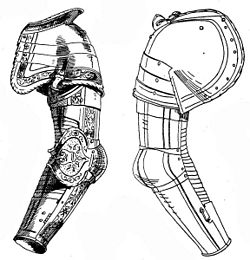Elbow tile
| Elbow tile | |
|---|---|

|
|
| Information | |
| Weapon type: | Protective weapon |
| Designations: | Elbow tiles, arm tiles, shells, mice (Cubiteres), elbow armor, elbow cobs, coude, coudiere, coute |
| Use: | armor |
| Creation time: | about 11th century |
| Working time: | until about 17th century |
| Region of origin / author: |
Europe , ethnic groups |
| Distribution: | Europe |
| Lists on the subject | |
The elbow tile , also arm tile , shell , mouse , elbow armor , is part of a plate armor from Europe.
description
The elbow tile is made of steel . It is designed to protect the elbow and the inside of the elbow joint. The development began with simple, flat plates (Mäusel, Cubiteres), slightly humped on the outside, which were attached to the chain armor and the arm protection plates facing outwards (around 1250 ). These preforms are not to be confused with the later armor and were only a primitive beginning to protect the arms. These specimens of the armguard were called "Abant-" or "Arrière-bras" in France. When the later, real, interconnected arm tools were developed (around 1600 ), they were given the French term "Brassard". The first real arm tools were developed in the 14th century . Around 1350 , the first arm tubes were made, which made the use of the elbow tiles possible. The endeavor to protect the bend of the elbow, which was open at the beginning of the development, led to the construction of a shell-shaped plate, which was initially made wide at the front end. The upper and lower arm armor consisted of steel rails. As development progressed, this plate became narrower at the front end and then ran around the arm without connecting to the arm armor and without the individual parts of the armor being connected to one another. All the individual parts of the armor were put on in a lengthy sequence. As the inside of the crook of the arm still seemed insufficiently protected as a result of this development, the armored personnel provided the forearm tubes with a barrel , in which plates sliding over each other also protected the inside without restricting the mobility of the arms. There are two different types of elbow tiles depending on their construction:
- Half tiles : With these, the elbow is protected, but the crook of the arm is unprotected.
- Whole tiles : With these, the elbow and the crook of the arm are completely protected.
The first complete tiles appear sporadically as early as 1480 on lancing tools and were used in tournament armor until around the 17th century , but were generally not widely used.
Around 1420 , the craftsmen at the Milan workshops came up with the idea of flexibly connecting the individual parts of the armor. First by a lacing, later by riveting . This resulted in better armor and avoidance of the complicated mooring. The method of attaching panels to one another was also related later in the 15th century to the leg pieces, which led to the development of the famous "Milanese harness".
Around 1450 , armor-makers began making arm tiles into huge sizes to demonstrate their artistry. The design in such sizes existed until around 1540 . The tiles were increasingly worked from the 16th century to be used on the tournament armor . A second, reinforcing tile (double or prickly mouse) (French: Garde-Bras). was screwed onto the existing arm tile. Smaller designed tiles were enlarged with attachments that were attached to the edge. These mice were only common in the so-called "Welschen Gestech".
literature
- Auguste Demmin : An Illustrated History of Arms and Armor from the earliest Period to the present time. Translated by CC Black. G. Bell & Sons, London 1901, p. 433 (Reprinted. Wildhern Press, Teddington 2008, ISBN 978-1-84830-049-1 ).
- Charles John Ffoulkes: The Armourer and His Craft. Methuen, London 1912, p. 109 (Reprinted. Cosimo Inc., New York NY 2008, ISBN 978-1-60520-412-3 ).
- Christopher Rothero: The armies of Agincourt (= Men-at-arms Series 113). Osprey Publishing, London 1981, ISBN 0-85045-394-1 , p. 38.
Individual evidence
- ↑ Wendelin Boeheim : Handbook of Armament. The weapon system in its historical development from the beginning of the Middle Ages to the end of the 18th century (= Seemanns Kunstgewerbliche Handbücher. Vol. 7, ZDB -ID 53757-3 ). Seemann, Leipzig 1890, pp. 73-77 (reprint. Fourier Verlag, Wiesbaden 1985, ISBN 3-201-00257-7 ).
- ↑ George Cameron Stone : A Glossary of the Construction, Decoration and Use of Arms and Armor in All Countries and in All Times. With an Introduction by Donald J. LaRocca. Courier Dover Publications, Mineola NY 1999, ISBN 0-486-40726-8 , pp. 215, 217.


